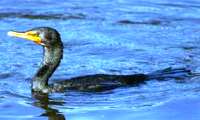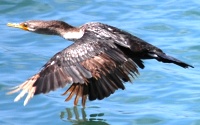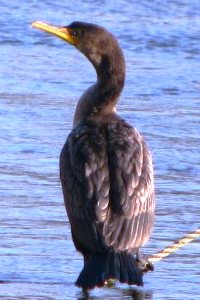(949) 675-0551 |
 |
DESCRIPTION: Double-crested Cormorants are large birds, growing over two feet long, with a wingspan of four feet. They are mostly black with an orange throat. They have a long neck and webbed feet. They are great swimmers and divers, as well as good flyers. |
 |
RANGE/HABITAT: Double-crested Cormorant is found from Alaska, Manitoba, and Newfoundland south to Mexico and Bahamas. It spends winters mainly on coasts north to Alaska and southern New England. Preferred habitats include lakes, rivers, swamps, and coasts. |
 |
BEHAVIOR: Double-crested Cormorants eat mostly fish. They dive underwater and hunt along the bottom. They eat a great variety of fish species, as well as other animals including: crayfish, shrimp, aquatic insects, amphibians (such as tadpoles and newts), snails, mussels, and some reptiles. Small fish are eaten immediately. Larger fish are taken to the surface where the cormorant flips it and swallows it head first. After feeding, cormorants need to dry their wings. They do not have oil in their skin to protect their feathers from getting wet, like ducks and other water birds do. Cormorants find a perch and stretch their wings out until they are dry. MATING/BREEDING: In breeding season, cormorants gather in colonies and build nests out of sticks, twigs, feathers, grass, bark, and trash. Nests are built in shrubs or trees. The female cormorant produces between 3 to 5 eggs. The eggs are a blue green color. Both the male and female care for eggs and chicks. Feeding the chicks is done through regurgitation, which is a common practice for birds. Young cormorants learn to fly within 6 weeks after hatching. Young cormorants are a brownish color and get darker with age. Double Crested Cormorants have an average life expectancy of 6 - 8 years.STATUS: Despite years of persecution by fishermen who viewed it as a competitor, the species is currently increasing in number and expanding its range. |
For Reservations Call: |
||
(949) 675-0551 |
||
Newport Beach Whale Watching 309 Palm St. #A - Newport Beach CA. 92661 |
||
Copyright © 2023 Newport Landing
Whale Watching |
Whale Watching | Whale Watching Dana Point Visitors | Whale Watching Long Beach Visitors | Whale Watching Los Angeles Visitors
Whale Watching San Diego Visitors | Huntington Beach Whale Watching | Whale Watching Laguna Beach | Catalina Island Whale Watching